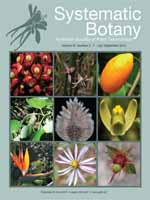The boundaries between the genera Bakeridesia and Abutilon have long been debated. Results from recent phylogenetic studies using the rDNA ITS in tribe Malveae strongly suggest that these two genera as currently delimited are polyphyletic. Some species previously included in each genus form a well-supported clade that is phylogenetically removed from both Bakeridesia and Abutilon. The congruence of morphological and karyological distinctions with this molecular evidence provides compelling support for recognition of the clade as a new genus, here described as Callianthe. In the present study we transfer 40 species to Callianthe based on ITS data (including the synapomorphy of a 25-base pair deletion in ITS2) and/or morphological evidence, including the character states of four or more ovules per carpel, toothed and/or lobed leaves, and petals with impressed veins (the latter is a synapomorphy). In addition, species of Callianthe share a base chromosome number of x = 8 (versus 7 in Abutilon and 15 in Bakeridesia). Not only is Callianthe phylogenetically removed from both Bakeridesia and Abutilon, but it is also morphologically distinct from its closest phylogenetic relative, Gaya, which has a base chromosome number of x = 6. Callianthe has a Neotropical distribution with a center of diversity in eastern Brazil. It includes all species previously referred to Bakeridesia subg. Dipteron and several large-flowered species previously referred to Abutilon. The following new combinations are made Callianthe amoena, C. andrade-limae, C. bedfordiana, C. bezerrae, C. brenesii, C. cyclonervosa, C. darwinii, C. elegans, C. fluviatilis, C. geminiflora, C. glaziovii, C. inaequalis, C. jaliscana, C. jujuiensis, C. lanata, C. latipetala, C. laxa, C. longifolia, C. macrantha, C. malmeana, C. mexiae, C. monteiroi, C. mouraei, C. muellerifriderici, C. pachecoana, C. petiolaris, C. pickellii, C. picta, C. purpusii, C. regnellii, C. rufinerva, C. rufivela, C. scabrida, C. schenckii, C. sellowiana, C. senilis, C. striata, C. torrendii, C. tridens, and C. vexillaris.
BioOne.org will be down briefly for maintenance on 17 December 2024 between 18:00-22:00 Pacific Time US. We apologize for any inconvenience.
How to translate text using browser tools
1 September 2012
Callianthe (Malvaceae): A New Genus of Neotropical Malveae
Aliya A. Donnell,
Harvey E. Ballard,
Philip D. Cantino
ACCESS THE FULL ARTICLE

Systematic Botany
Vol. 37 • No. 3
July 2012
Vol. 37 • No. 3
July 2012
Abutilon
Bakeridesia
Brazil
ITS




